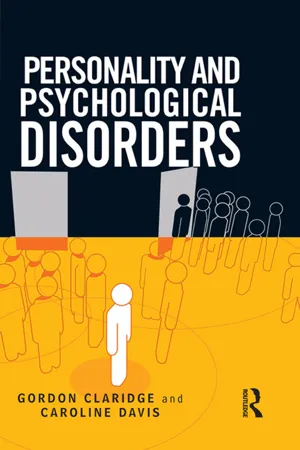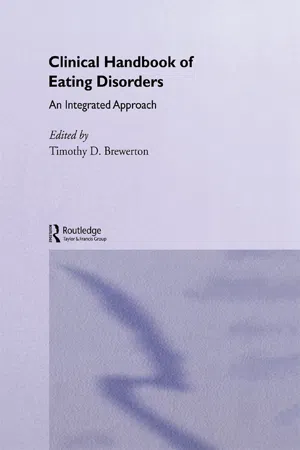Causes of Eating Disorders
Eating disorders can be caused by a combination of genetic, psychological, environmental, and social factors. Genetic predisposition, low self-esteem, societal pressure for thinness, and traumatic life events are often cited as contributing factors. Additionally, personality traits such as perfectionism and impulsivity can also play a role in the development of eating disorders.
8 Key excerpts on "Causes of Eating Disorders"
- Anne Claveirole, Martin Gaughan, Anne Claveirole, Martin Gaughan(Authors)
- 2011(Publication Date)
- Wiley-Blackwell(Publisher)
...Also, many experts contend that no one risk factor is ever likely to explain disorders so inherently complex (Nicholls 2007). Instead, eating disorders research examines a number of key causative theories and associated risk and resilience factors. Unsurprisingly, some of this research is contentious and intermittently contradictory. The solution to these problems lies with a pragmatic approach that eating disorders arise as a combination of biological, psychological and social forces (Lucas 2008). The precise interaction involved is unique to each person, as is the trigger to their illness beginning, and often their paths to recovery (Lucas 2008). It is only at certain points, e.g. when people are starving as a result of anorexic behaviour that eating disorders appear similar (Lucas 2008). We will now examine the main biological, psychological and social themes in turn. Biological Factors Genetic vulnerability Most psychiatrists are confident that eating disorders run in families, although researchers are unsure exactly how that risk is realised, including the extent of inherited traits, such as perfectionism, versus environmental influences (Goodman and Scott 2005, Nicholls 2007, Treasure 2007). The number of genes involved and the precise extent to which they influence the development of a disorder are also unknown and vary in the literature. Lucas (2008), for example, states that genes account for up to 70% of a disorder developing, with the remaining 30% arising from a person’s environment. Neurological vulnerability Neuroscientific research proposes that specific deficits in brain structures and functions are involved in eating disorders, and that the neurological, physical and social changes puberty brings influence their development (Southgate et al. 2005)...
- Amy E. Wenzel(Author)
- 2017(Publication Date)
- SAGE Publications, Inc(Publisher)
...Stacey C. Cahn Stacey C. Cahn Cahn, Stacey C. Francine R. Broder Francine R. Broder Broder, Francine R. Eating Disorders: Psychological Factors Eating disorders: Psychological factors 1268 1270 Eating Disorders: Psychological Factors Eating disorders (EDs) are serious mental health disorders characterized by disordered eating behaviors, overevaluation of weight and shape, and preoccupation with food. Although disordered eating is often the most conspicuous symptom, at their core, EDs are fundamentally psychological disorders. This entry briefly reviews important psychological factors (cognitive and emotional) that are relevant to the onset and maintenance of the three primary EDs: (1) anorexia nervosa (AN), (2) bulimia nervosa (BN), and (3) binge eating disorder (BED). Cognitive Factors Individuals with eating disorders have elevated levels of alexithymia, which is characterized by difficulty in identifying thoughts and feelings, and in differentiating between feelings and bodily sensations. It is theorized that individuals with eating disorders experience emotions as unacceptable and may use disordered eating as a means to cope with their thoughts or feelings. Clinical perfectionism is a personality trait that consists of unrelenting, unattainable standards and mistake intolerance. Clinical perfectionism is believed to play a role in both the etiology and the maintenance of EDs and is a specific risk factor for AN; research suggests that high levels of perfectionism generally persist after recovery from EDs. Whereas general, or multidimensional, perfectionism can indicate a positive striving for excellence, clinical perfectionism entails self-evaluation based on self-imposed standards that are unrealistic and unrelenting. Whereas general perfectionism may confer an advantage in many professional and personal domains, clinical perfectionism can ultimately lead to impaired mood and functioning as failures are inevitable and continually met with self-criticism...
- eBook - ePub
- Gordon Claridge, Caroline Davis(Authors)
- 2013(Publication Date)
- Routledge(Publisher)
...Clinically, the behaviours that define these disorders are very similar. Moreover, very similar biological mechanisms can explain the progression from ‘use’ to ‘abuse’ that we see in both disorders – in the case of drugs, from a recreational habit to a state of pathological dependence; in anorexia nervosa, from casual dieting to a life-threatening refusal to eat; and in bulimia nervosa to the increasing inability to resist large quantities of food. Finally, there is support for a common psychobiological vulnerability. We know, for instance, that individuals tend to ‘self-medicate’ their affective disturbances with a variety of rewarding behaviours based, to some extent, on the specific effects of each (Chutuape & Dewit, 1995; Khantzian, 1997; Markau et al., 1998). Here, it is interesting to consider why some individuals choose nicotine, others alcohol, and others food to regulate mood. Clearly, personality, environment, and sociocultural factors have considerable influence in the choices that are made. The obsessional, perfectionistic, anxious, and conforming nature that characterizes many anorexic patients makes it easier to understand the compelling attraction of appearance-enhancing behaviours, such as dieting and exercise, since there are many social and psychological rewards that accrue to those who can achieve the cultural standards of thinness. The Pathophysiology of Eating Disorders However, in order to understand the motivation to continue these behaviours beyond the point of body-image improvements – and in the face of life-threatening medical complications – we must move beyond psychosocial explanations. When a person begins to diet, what often starts as a casual attempt to lose a few pounds can become, in certain vulnerable individuals, a time-consuming preoccupation with weight and body shape. Indeed, for some, the initial loss of weight is even involuntary, stemming from a mood or illness-induced absence of appetite...
- eBook - ePub
Clinical Handbook of Eating Disorders
An Integrated Approach
- Timothy D. Brewerton, Timothy D. Brewerton(Authors)
- 2004(Publication Date)
- CRC Press(Publisher)
...6 An Overview of Risk Factors for Anorexia Nervosa, Bulimia Nervosa, and Binge Eating Disorder Corinna Jacobi University of Trier Trier, Germany Lisette Morris University of Göttingen Göttingen, Germany Martina de Zwaan Friedrich Alexander University Erlangen-Nuremberg Erlangen, Germany In the field of eating disorders, more than 30 variables have been reported as risk factors for the development of an eating disorder (Table 1). Among these variables, risk has been assessed from different perspectives: reported risk factors include social, familial, psychological, developmental, and biological factors. For many of these factors, the question of whether they occurred prior to the onset of the eating disorder has not yet been definitively answered. Therefore, it is impossible to determine whether they are symptoms, maintaining factors, consequences, or “scars” of the disorder. The inconsistent use of the term risk factor as well as the lack of precise definitions led Kraemer and coworkers to set out a conceptual basis for a typology of risk factors (1, 2). This theoretical framework forms the basis of our overview on risk factors for eating disorders. In the past, risk and etiological factors for eating disorders have either been proposed from a specific theoretical perspective (e.g., biological, cognitive-behavioral, psychodynamic) or from an integrative perspective (e.g., biopsychosocial model). Factors in these models can be based on both clinical experience and empirical data, but the empirical foundation can vary from very strong to very weak and can comprise a wide range of methods and definitions for risk and etiologic factors...
- eBook - ePub
Exercise and Eating Disorders
An Ethical and Legal Analysis
- Simona Giordano(Author)
- 2010(Publication Date)
- Routledge(Publisher)
...3 Biological and clinical explanations of eating disorders 1 Introduction Understanding the Causes of Eating Disorders is important to determine the best course of action with eating-disordered exercisers. If eating disorders were a biological illness, or an addiction, it would be imperative to involve qualified and specialized medical personnel. If they were mainly the result of free choice, this would mean that, at least in principle, negotiation with the sufferer is possible. Little negotiation, if any, instead, is possible with someone affected by a neurological or genetic disorder. If an Alzheimer’s patient is carelessly crossing a busy road with incoming traffic while in a confused state, there is limited scope for dialogue with the sufferer. She cannot help it. Where self-harm cannot be explained exclusively in terms of determining biological factors, this indicates that the person retains the power to choose, on some level at least, that this is the behavior s/he will adopt. Those who have the strength of will to inflict so much pain on themselves should have, and often do have, enough strength to resolve the conflicts that lead them to fight against their own self. For these reasons, understanding the Causes of Eating Disorders is ethically relevant. It puts the condition into context, and helps us to find out whether paternalism is ethically mandatory or whether, instead, there is sufficient scope for meaningful dialogue. This and the next two chapters will therefore discuss the various possible Causes of Eating Disorders...
- (Author)
- 2020(Publication Date)
- Wiley(Publisher)
...Eating Disorders Jennifer Barney, Arielle Wolinsky, and Adrienne S. Juarascio Drexel University Eating disorders (EDs) are complex psychiatric disorders characterized by disturbances in an individual’s eating and related behaviors, resulting in psychological distress, health concerns, and reduced quality of life. These disorders can arise from many combinations of psychological, biological, and social risk factors and can lead to potentially life‐threatening behaviors and thought patterns surrounding one’s eating and weight. Individual variability of symptomology, diagnostic crossover, and difficulty distinguishing disordered eating from normal‐range eating behaviors, often make diagnosing and treating EDs very difficult. While the Diagnostic and Statistical Manual of Mental Disorders, fifth edition (DSM‐V), outlines some of the more common presentations of ED symptoms, (which are described in greater detail below), individual risk factors and various treatment methods that have been utilized for varying EDs are also reviewed. Anorexia Nervosa AN is characterized within the DSM‐V as: (1) persistent restriction of energy intake resulting in significantly low body weight; (2) intense fear of gaining weight or becoming heavy, or persistent behaviors that interfere with necessary weight gain; and (3) disturbance in the way one’s body weight or shape is experienced. Two subtypes may also be specified within the diagnosis of AN when appropriate: (1) Restricting, describing presentations of symptoms in which only caloric restriction and/or excessive exercise are present or (2) binge/purge (AN‐BP), describing presentations where binge eating and purging behaviors (e.g. self‐induced vomiting, laxative misuse) are also present, concurrent with the first three diagnostic AN criteria...
- eBook - ePub
Future Work in Clinical Child and Adolescent Psychology
A research agenda
- Mitchell J. Prinstein, Mitchell J. Prinstein(Authors)
- 2018(Publication Date)
- Routledge(Publisher)
...The goal of the present article is to offer suggestions regarding potentially fruitful directions for future research in each of these lines of inquiry. ETIOLOGIC RESEARCH The etiology of eating disorders presumably involves a combination of genetic, biological, and temperamental vulnerabilities that interact with environmental circumstances to increase risk. Although data from twin studies indicate that genes play an important role in the etiology of eating disorders, suggesting that between 50 and 80% of the variance in anorexia nervosa and bulimia nervosa is explained by genetic factors (Klump, Suisman, Burt, Mugue, & Iacono, 2009), no consistent findings have emerged regarding the effects of particular genotypes to date, despite an enormous amount of research. Likewise, there have been dozens of studies on biological correlates of eating disorders, though few clear results have emerged regarding potential vulnerability factors. Research has found that individuals with versus without eating disorders show abnormalities in temperamental and personality traits, hormone levels, the monoamine systems (specifically the serotonergic system), striatal dopamine function, altered responsiveness in certain brain regions, and appetitive regulation (Kaye, 2008; Steiger & Bruce, 2007). However, because virtually all of these studies are cross-sectional, they are unable to determine whether these abnormalities represent initial vulnerability factors or consequences of disordered eating...
- eBook - ePub
- Linda Smolak, Michael P. Levine(Authors)
- 2015(Publication Date)
- Wiley-Blackwell(Publisher)
...Thus, explaining the decision to restrict calories may be a particularly important component of any model attempting to explain the developmental pathways to AN and BN. Other Characteristics Most models of EDs focus on factors other than the body image and eating disturbances. For example, genetic models often emphasize genetically mediated variables such as temperament, including harm avoidance, while neuroscience perspectives describe neurochemical and hormonal differences between those diagnosed with ED and other women (Kaye et al., 2012, 2013; Striegel-Moore & Bulik, 2007; Strober & Johnson, 2012). Sociocultural models may highlight individual difference variables, including high levels of negative affect or a tendency to engage in social comparison (Stice, 2001; Thompson et al., 1999). Table 67.1 lists and briefly describes some of the more commonly cited differences between clinical EDs and control samples. Note that these factors represent differences, which are essentially correlations, and not necessarily causal relationships. Table 67.1 Characteristics of eating disorders (EDs), beyond body image and eating patterns, that theories should consider. Variable Comment Cognition Weight and shape schema may determine how people interpret messages and experiences. Information processing biases re food and weight. Rigid, absolute thinking concerning body Comorbidity Most people with ED diagnoses also have other diagnoses. Depression and anxiety disorders are particularly common Culture The nature, type, and frequency of ED appears to vary across cultures. Cultural research also indicates that the introduction of American media or body image values may increase ED Ethnicity In the United States Blacks may experience fewer restricting EDs but not be “protected” against other forms. Other U.S. ethnic differences have not been consistently documented Gender Women experience EDs, particularly AN and BN, at higher rates than men...







